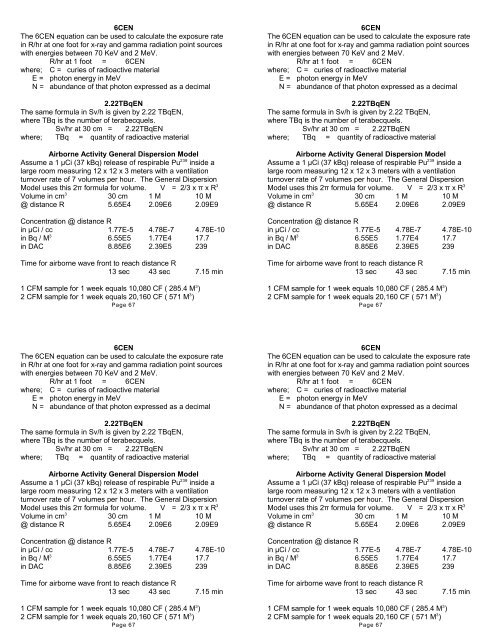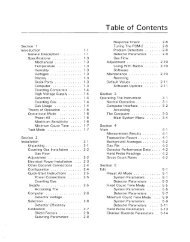Gilson and Voss - Voss Associates
Gilson and Voss - Voss Associates
Gilson and Voss - Voss Associates
Create successful ePaper yourself
Turn your PDF publications into a flip-book with our unique Google optimized e-Paper software.
6CEN<br />
The 6CEN equation can be used to calculate the exposure rate<br />
in R/hr at one foot for x-ray <strong>and</strong> gamma radiation point sources<br />
with energies between 70 KeV <strong>and</strong> 2 MeV.<br />
R/hr at 1 foot = 6CEN<br />
where; C = curies of radioactive material<br />
E = photon energy in MeV<br />
N = abundance of that photon expressed as a decimal<br />
2.22TBqEN<br />
The same formula in Sv/h is given by 2.22 TBqEN,<br />
where TBq is the number of terabecquels.<br />
Sv/hr at 30 cm = 2.22TBqEN<br />
where; TBq = quantity of radioactive material<br />
Airborne Activity General Dispersion Model<br />
239<br />
Assume a 1 ìCi (37 kBq) release of respirable Pu inside a<br />
large room measuring 12 x 12 x 3 meters with a ventilation<br />
turnover rate of 7 volumes per hour. The General Dispersion<br />
Model uses this 2ð formula for volume. V = 2/3 x ð x R 3<br />
3<br />
Volume in cm 30 cm 1 M 10 M<br />
@ distance R 5.65E4 2.09E6 2.09E9<br />
Concentration @ distance R<br />
in ìCi / cc 1.77E-5 4.78E-7 4.78E-10<br />
3<br />
in Bq / M 6.55E5 1.77E4 17.7<br />
in DAC 8.85E6 2.39E5 239<br />
Time for airborne wave front to reach distance R<br />
13 sec 43 sec 7.15 min<br />
1 CFM sample for 1 week equals 10,080 CF ( 285.4 M 3 )<br />
3<br />
2 CFM sample for 1 week equals 20,160 CF ( 571 M )<br />
Page 67<br />
6CEN<br />
The 6CEN equation can be used to calculate the exposure rate<br />
in R/hr at one foot for x-ray <strong>and</strong> gamma radiation point sources<br />
with energies between 70 KeV <strong>and</strong> 2 MeV.<br />
R/hr at 1 foot = 6CEN<br />
where; C = curies of radioactive material<br />
E = photon energy in MeV<br />
N = abundance of that photon expressed as a decimal<br />
2.22TBqEN<br />
The same formula in Sv/h is given by 2.22 TBqEN,<br />
where TBq is the number of terabecquels.<br />
Sv/hr at 30 cm = 2.22TBqEN<br />
where; TBq = quantity of radioactive material<br />
Airborne Activity General Dispersion Model<br />
239<br />
Assume a 1 ìCi (37 kBq) release of respirable Pu inside a<br />
large room measuring 12 x 12 x 3 meters with a ventilation<br />
turnover rate of 7 volumes per hour. The General Dispersion<br />
Model uses this 2ð formula for volume. V = 2/3 x ð x R 3<br />
3<br />
Volume in cm 30 cm 1 M 10 M<br />
@ distance R 5.65E4 2.09E6 2.09E9<br />
Concentration @ distance R<br />
in ìCi / cc 1.77E-5 4.78E-7 4.78E-10<br />
3<br />
in Bq / M 6.55E5 1.77E4 17.7<br />
in DAC 8.85E6 2.39E5 239<br />
Time for airborne wave front to reach distance R<br />
13 sec 43 sec 7.15 min<br />
1 CFM sample for 1 week equals 10,080 CF ( 285.4 M 3 )<br />
3<br />
2 CFM sample for 1 week equals 20,160 CF ( 571 M )<br />
Page 67<br />
6CEN<br />
The 6CEN equation can be used to calculate the exposure rate<br />
in R/hr at one foot for x-ray <strong>and</strong> gamma radiation point sources<br />
with energies between 70 KeV <strong>and</strong> 2 MeV.<br />
R/hr at 1 foot = 6CEN<br />
where; C = curies of radioactive material<br />
E = photon energy in MeV<br />
N = abundance of that photon expressed as a decimal<br />
2.22TBqEN<br />
The same formula in Sv/h is given by 2.22 TBqEN,<br />
where TBq is the number of terabecquels.<br />
Sv/hr at 30 cm = 2.22TBqEN<br />
where; TBq = quantity of radioactive material<br />
Airborne Activity General Dispersion Model<br />
239<br />
Assume a 1 ìCi (37 kBq) release of respirable Pu inside a<br />
large room measuring 12 x 12 x 3 meters with a ventilation<br />
turnover rate of 7 volumes per hour. The General Dispersion<br />
Model uses this 2ð formula for volume. V = 2/3 x ð x R 3<br />
3<br />
Volume in cm 30 cm 1 M 10 M<br />
@ distance R 5.65E4 2.09E6 2.09E9<br />
Concentration @ distance R<br />
in ìCi / cc 1.77E-5 4.78E-7 4.78E-10<br />
3<br />
in Bq / M 6.55E5 1.77E4 17.7<br />
in DAC 8.85E6 2.39E5 239<br />
Time for airborne wave front to reach distance R<br />
13 sec 43 sec 7.15 min<br />
1 CFM sample for 1 week equals 10,080 CF ( 285.4 M 3 )<br />
3<br />
2 CFM sample for 1 week equals 20,160 CF ( 571 M )<br />
Page 67<br />
6CEN<br />
The 6CEN equation can be used to calculate the exposure rate<br />
in R/hr at one foot for x-ray <strong>and</strong> gamma radiation point sources<br />
with energies between 70 KeV <strong>and</strong> 2 MeV.<br />
R/hr at 1 foot = 6CEN<br />
where; C = curies of radioactive material<br />
E = photon energy in MeV<br />
N = abundance of that photon expressed as a decimal<br />
2.22TBqEN<br />
The same formula in Sv/h is given by 2.22 TBqEN,<br />
where TBq is the number of terabecquels.<br />
Sv/hr at 30 cm = 2.22TBqEN<br />
where; TBq = quantity of radioactive material<br />
Airborne Activity General Dispersion Model<br />
239<br />
Assume a 1 ìCi (37 kBq) release of respirable Pu inside a<br />
large room measuring 12 x 12 x 3 meters with a ventilation<br />
turnover rate of 7 volumes per hour. The General Dispersion<br />
Model uses this 2ð formula for volume. V = 2/3 x ð x R 3<br />
3<br />
Volume in cm 30 cm 1 M 10 M<br />
@ distance R 5.65E4 2.09E6 2.09E9<br />
Concentration @ distance R<br />
in ìCi / cc 1.77E-5 4.78E-7 4.78E-10<br />
3<br />
in Bq / M 6.55E5 1.77E4 17.7<br />
in DAC 8.85E6 2.39E5 239<br />
Time for airborne wave front to reach distance R<br />
13 sec 43 sec 7.15 min<br />
1 CFM sample for 1 week equals 10,080 CF ( 285.4 M 3 )<br />
3<br />
2 CFM sample for 1 week equals 20,160 CF ( 571 M )<br />
Page 67













